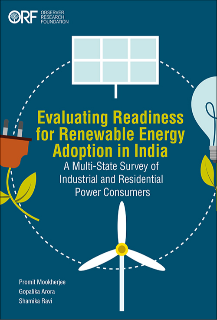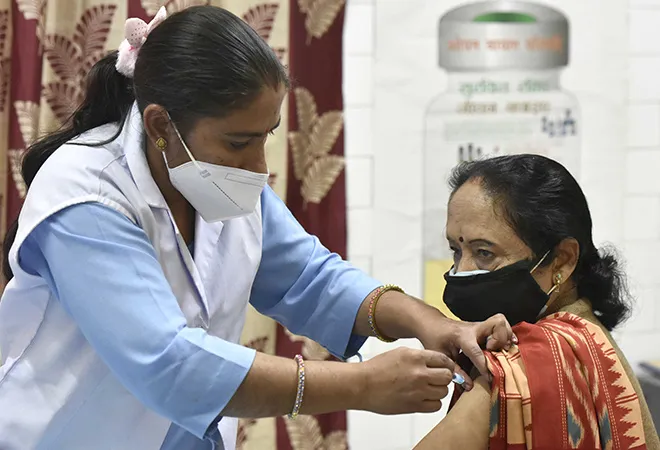
(This is part of the weekly series assessing the Covid-19 vaccine rollout in India and the world)
The COVID-19 vaccination drive has been a crucial turning point in fighting the ongoing pandemic. For a country as vast as India, the long-awaited vaccines aim to preserve the health system from further burden as well as protect the health of the people, especially the vulnerable and elderly.
India has administered more than 55 million COVID-19 vaccine doses, marking it as the third most inoculated country in the world. Relative to population, the country has administered four doses per 100 people.
India’s weekly average vaccination rate has surpassed 2.3 million, doubling in the past 2 weeks. At the current rate, it will take India 2.4 years to cover 75 percent of its population. India’s steady rise in reach of inoculations has led to a fall in the coverage rate from 4.2 years to 2.4 years in the past week.
Figure 1: Covid Vaccine Trends in India
 Author’s own, Data source: Covid19India
Author’s own, Data source: Covid19India
Last week, India conducted approximately 15 million inoculations, with a record of more than 3.4 million doses yesterday itself. This week, the country has already surpassed 10 million in the past four days (from March-22 to March-25). While the initial response to the vaccination was lukewarm, the country has more than doubled its weekly average rate of vaccination in the past three weeks.
The recent rise in the number of cases has further led to a rise in inoculations. 59,075 new cases were reported in the last 24 hours, the highest single-day rise seen since mid-October last year. Furthermore, the new ‘double mutant variant’ of SARS-CoV-2 has been detected in 18 states, in addition to other variants from the UK and South Africa, has led to citizens fearing the disease, thereby spurring them to vaccinate. Eighty one percent of the 401 samples sent for genome testing in Punjab have turned up positive for the UK covid variant.
Within India, Maharashtra has now taken the lead in COVID-19 inoculations, with 5.22 million shots. The state currently accounts for 61 percent of the new COVID cases. In terms of total vaccine doses, Maharashtra is closely followed by Rajasthan (5.05 million) and Uttar Pradesh (5.02 million). A key contributor to cases, Delhi seems to lag behind with only 1.1 million inoculations in the past two months. Similarly, Punjab has observed a surge in new cases in the past few week with multiple cases of newer virulent virus variation, however, the state’s vaccination drive remains stagnant with only 0.57 million shots as on date.
Relative to population, Ladakh leads with 15.7 doses per 100 people, however, Bihar (1.9) and Uttar Pradesh (2.1), are the worst faring states. States such as Uttar Pradesh, Maharashtra, Bihar, and West Bengal, with a high elderly population, require acute focus on their vaccination programme. These states also account for a higher case load, and therefore need to enhance the efficacy of the vaccination drive.
Figure 2: Covid Vaccine Trends in Indian States
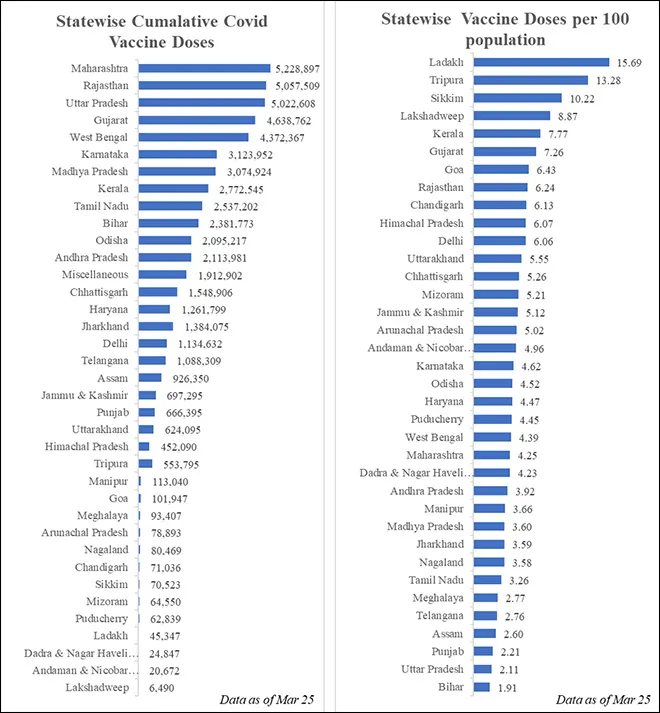 Author’s Own, Data source: Observer Research Foundation Vaccine Tracker
Author’s Own, Data source: Observer Research Foundation Vaccine Tracker
Post initiation of the second phase of its vaccination drive to include both people over 60 years of age and those aged 45 and above with co-morbid conditions, the average daily vaccination in India has quadrupled. As per the Ministry of Health and Family Welfare, 23 million people over the age of 60 and five million people between 45-60 years with co-morbidities have been vaccinated as on date.
Around 8.5 million of India’s population has been completely vaccinated, as on date. To attain the target of vaccinating a quarter of its population by August, the momentum of the vaccination programme must be maintained. This week, it was announced that the country will be opening the vaccination drive to all those above 45 years of age, irrespective of co-morbidities. While the vaccination drive has been gradually increasing, amid the spread of new covid variants—vaccinating the priority population of 45 and above is increasingly important.
Global Context
Globally, more than 500 million doses have been administered across 140 countries. Last week, 75 million COVID-19 inoculations were conducted around the world. The average daily rate of inoculations has risen to 12.2 million doses per day, which has halved the time needed to cover 75 percent of the global population from 5 years to 2.5 years in the past few weeks. The coverage rate has been steadily declining in the past few weeks, owing to the steady rise of inoculations per country and the number of countries inoculating.
Figure 3: Country wise Covid vaccine doses administered
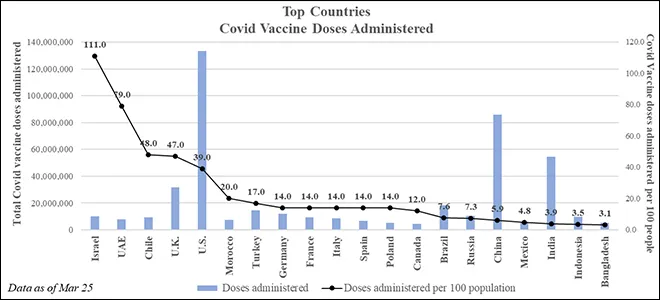 Author’s own, Data source: Bloomberg Vaccine tracker, as on March 26, 1100 hrs
Author’s own, Data source: Bloomberg Vaccine tracker, as on March 26, 1100 hrs
The COVID vaccine drive continues to be dominated by the United States, with over 133 million doses administered, as of Mar 25, followed by China (85 million), and India (55 million). In terms of daily rate of doses administered, USA leads with 2.5 million average daily doses, followed by China (2.27 million doses) and India (2.25 million doses).
#VaccineMaitri
In the four countries that have covered at least 25 percent of their population with COVID vaccines, COVID-19 infection rates have either flattened or declined. Though delivering vaccinations to the global population is a gigantic distributional and logistic challenge, the importance of the process cannot be understated.
Out of the total COVID vaccines administered globally, the US, EU and UK account for almost 50 percent of the doses. Many countries, especially in Africa, are yet to initiate the COVID-19 vaccine drives. While North American and European countries have administered 24 and 14 doses per 100 people, respectively; African countries lag behind with 0.7 doses per 100 population.
Figure 4: Vaccination doses administered in the World
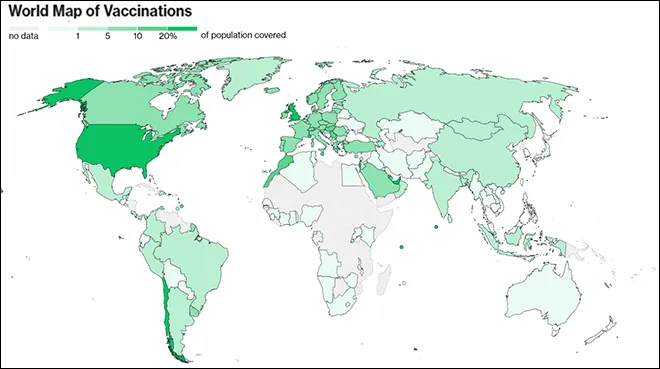 Author’s own, Data source: Bloomberg Vaccine tracker, as on March 26, 1100 hrs
Author’s own, Data source: Bloomberg Vaccine tracker, as on March 26, 1100 hrs
Disparity in the vaccination process continues to persist. Out of 72 countries that are yet to start COVID vaccination, 63 belong to the developing world. Non-wealthy countries are currently mostly dependent on the COVAX initiative for their vaccination drives; however, the gap between doses administered in rich countries versus those through COVAX continues to increase.
Amidst uncertainty, India continues to provide vaccines to its partner countries. As of March 26th, the country has supplied over 60.5 million doses, out of which 8.5 million were grants and 34 million were commercial agreements. Furthermore, India has supplied over 17.8 million doses to the COVAX initiative. India’s efforts have been key to many developing countries being able to initiate COVID vaccine drives.
Figure 5: India’s global supply of vaccines
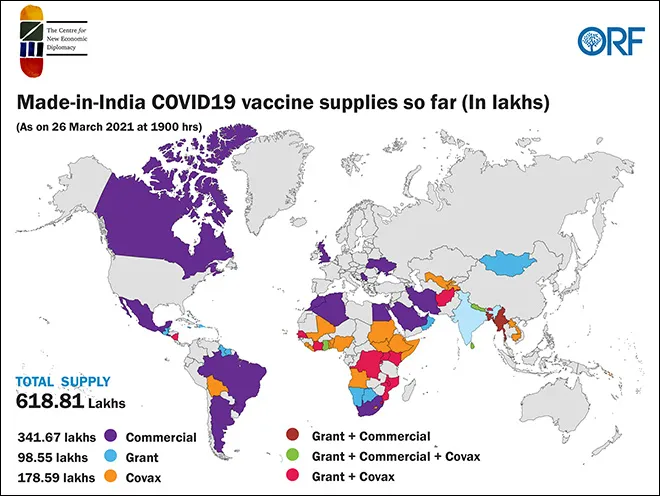 Author’s own, Data source: Ministry of External Affairs, Government of India
Author’s own, Data source: Ministry of External Affairs, Government of India
Despite sharing doses with more than 75 countries, India has maintained a consistent rise in inoculations internally. With rumours circulating that the country will be imposing a ban on vaccine exports, the Government of India has clarified that it will continue to supply vaccines to its partner countries in a phased manner.
The country is positive that even with the rising exports, it will be able to support the third phase of vaccination. India has indeed expanded vaccination to anyone above 45 years old from April 1st. However, as India has an incredibly young population, this amounts to just under 20 percent of the population (280 million). This means the original 300 million plan may not have to be extended by a huge margin. India, at max, plans to cover 30-40 percent of the population as of now, a goal similar to that of China’s, which reportedly plans to cover 40 percent of its population. With this momentum and a rise of average daily inoculations to five million, India should be able to attain its target of vaccinating the priority and vulnerable population by August 2021.
The views expressed above belong to the author(s). ORF research and analyses now available on Telegram! Click here to access our curated content — blogs, longforms and interviews.




 Author’s own, Data source:
Author’s own, Data source:  Author’s Own, Data source:
Author’s Own, Data source:  Author’s own, Data source:
Author’s own, Data source:  Author’s own, Data source:
Author’s own, Data source:  Author’s own, Data source:
Author’s own, Data source:  PREV
PREV

